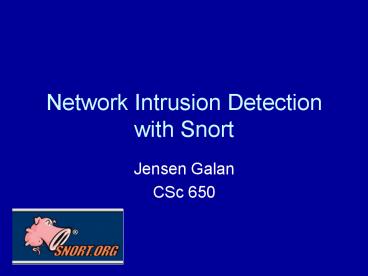Network Intrusion Detection with Snort PowerPoint PPT Presentation
1 / 19
Title: Network Intrusion Detection with Snort
1
Network Intrusion Detection with Snort
- Jensen Galan
- CSc 650
2
What is Snort?
- An Open-Source Network Intrusion Detection system
- Monitors activity to identify malicious or
suspicious events - Real-time traffic analysis / Packet Sniffing
Logging on IP networks
3
How does Snort work?
- Signature-based (pattern-matching)
- Boyer-Moore string matching algorithm
- Not anomaly-based (but, Securimine for Snort adds
functionality)
4
4 Basic Components
- The sniffer
- The preprocessor
- The detection engine
- The output
5
Packet Sniffer
- Uses libpcap - packet capture library for Linux
systems - Also a version for Windows - WinPcap
- IP traffic includes TCP, UDP, ICMP
- Configure NIC in promiscuous mode
6
Preprocessor
- Takes raw packets and checks them against enabled
plug-ins - Notable preprocessors
- frag2
- stream4
- portscan
- http_decode
7
frag2 Preprocessor
- Fragmented packets are reassembled before being
sent to detection engine - Normal on networks for packets to be fragmented
(MTU) - Also a way to avoid pattern-matching systems
8
stream4 Preprocessor
- Designed to make Snort stateful
- Snort builds own state tables
- Check to see if packet part of established
connection - Ex alert on stealth Fin scan -Nmap
- Rebuild full session data wth Sguil
9
portscan Preprocessors
- Detect portscans
- Attackers use port scanners to detect which ports
are open - Ex send SYN to server - replies with SYN/ACK if
open, RST/ACK if closed - Only detects over certain period of time
10
http_decode
- Attackers can use different equivalent
expressions to avoid pattern-matching - IIS accepts Unicode hexadecimal encoding
- http_decode normalizes URI (part after server
name in URL) before matching with rules
11
Detection Engine
- Core of the IDS in Snort
- Takes the data from the preprocessors and checks
against the set of enabled rules - Rules have two parts
- Header - action to take, type of packet, IP
addresses, ports - Option - content in the packet to match with rule
12
Example Rule
- Alert tcp EXTERNAL_NET any -gt HTTP_SERVERS
HTTP_PORTS (msgWEB-MISC http directory
traversal flowto_server, established
content../ referencearachnids,297
classtypeattempted-recon sid1113) - Nimda footprint
13
Output Component
- Many output options - can also write custom
output plug-in - Syslog file
- Database - MySQL, PostgreSQL, etc.
- Snort Unified Binary Format - Fastest!
14
Where to Deploy Snort?
15
Problems with Snort
- False Positives - must custom tune rules engine
for environment update consistently - Not picking up all the packets - database writes
expensive use Barnyard to decouple - Interface
16
Snort Tools
- ACID / BASE - Browser based (Apache, PHP,
database plug-in) - Honeynet Security Console - Windows based
stand-alone - Sguil - Real-time analysis complete session data
17
Snort Tools (cont.)
- Oinkmaster - Perl script to update rules
- Barnyard - decouple Snort and expensive database
writes - SFS - adds layer of anomaly based detection to
Snort
18
Snort as an Inline IDS
- Operate Snort in conjunction with firewall
(IPtables) - Drop packets based on set of rules
- Can PREVENT intrusion instead of merely DETECTING
19
References
- http//userwww.sfsu.edu/jrgalan/650_presentation.
ppt - http//www.snort.org/
- http//sourceforge.net/projects/secureideas/
- Snort 2.0 Intrusion Detection, Caswell, Brian,
Syngress Publishing 2003. - Security in Computing, Pfleeger, Charles,
Prentice Hall, 2003.

